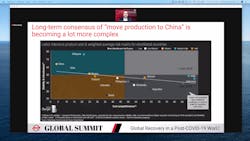Miles driven are rebounding, ecommerce is booming, and trends toward crossovers and SUVs are driving repair and maintenance costs.
Many good things are happening in the aftermarket, despite the pandemic and its ongoing disruption of daily life. Paul McCarthy, president of the Automotive Aftermarket Suppliers Association kicked off the Global Summit today, offering insights on the aftermarket, what is to come, and what, if anything the industry should truly be worried about.
Describing supply chain disruption of the sort that we haven’t seen in decades, “the aftermarket has been shaken. It has also proved amazingly resilient,” McCarthy said. Although business has been challenging, the industry remains vital to giving consumers the ability to have safe, affordable access to the freedom of mobility. McCarthy covered a few key industry trends and what they mean for the market long term.
Future aftermarket manufacturing footprint
In our new world, there is not a simple answer as to where companies should look to set up manufacturing hubs. The long-term consensus of “move production to China” is becoming a lot more complex (Figure 1). We are seeing the end of “cheap” China, and in its place seeing increasing wages, more competition for parts and rising tariffs.
China historically has offered a significant combination of cost competitiveness and infrastructure. But other countries — Latin America, Mexico, Southeast Asia and India — all continue to challenge traditional norms and are delivering new cost advantages for manufacturers. As a result, we’ve seen many companies relocating manufacturing facilities.
The future of manufacturing is hard to predict, as the U.S. trade policy remains uncertain, McCarthy said. He also noted that tariffs aren’t expected to go away in 2021. This will most likely lead to a complex and multi-country aftermarket production base where there is opportunity but also considerable competition.
Future of miles driven
The pandemic has triggered tremendous change: the shift to work from home, online shopping, public transportation being replaced by private and a flight to the suburbs. There is a lot of uncertainty about these trends and how they will play out post-pandemic. However, these lifestyle shifts may be supportive of aftermarket demand, McCarthy said (Figure 2).
As mentioned, ecommerce surged in the aftermarket in 2020. In 2019, it had grown 9.4 percent, but saw an increase of 23.5 percent in 2020. The timing was lucky, McCarthy noted, because most existing players had already made big investments in omnichannel marketing. “If the pandemic had hit five years ago, we might have seen very different market shifts,” he said.
Pre-COVID, the industry had also seen record miles driven globally, and forecasted to continue to grow significantly, Although miles driven were down in 2020, with the largest drop seen in April, the gap has narrowed as the pandemic progressed. As of October 2020, miles driven were only down 6 percent (Figure 3), McCarthy said.
Miles driven are being impacted by “risk of infection,” which is playing a large role in how consumers make transportation choices. Citing an AASA survey conducted last year, 32 percent said they will more frequently by private car; 40 percent will fly less and 32 percent will travel by train less. Regardless how they travel, post-pandemic, “the overall desire of consumers for movement remains intact,” (Figure 4) McCarthy said.
U.S. used car valuations also reached a 51-year all-time high in August. “People are finding they need or want a car or a second or third car,” McCarthy said, and also referenced the New York Times declaration that a car is “the ultimate PPE (personal protective equipment).”
The new normal may see less white-collar commuting, but we are also seeing a structural shift of less public transport and more moving to the suburbs, which requires more travel. “If you are commuting less, you can live where you want to live. And if people can afford it, they often want to live in places where you need a car,” McCarthy said.
The types of vehicles being purchased are also giving the aftermarket a boost. The current shift to trucks and crossovers is good for aftermarket dollar growth, as they show a 12.5 percent increase in per-mile repair and maintenance costs versus smaller vehicles (Figure 5). “Bigger, heavier vehicles with more capability are more expensive to repair,” McCarthy said.
Disruptive vehicle technology
The pandemic has set back the already fading promise of full autonomy, but ADAS offerings have been and will be good for the aftermarket. An expanding array of new product opportunities, sensors and electronics are all items that need to be calibrated and can break, McCarthy said (Figure 6).
Electrification also continues to grow, with 88 percent of new light vehicles sold predicted to have electrification technology by 2031. However, the impact on the vehicle parc will be slow given the huge installed base. By 2050 two thirds of the global parc will still have an internal combustion engine (ICE), according to IHS Markit.
While some say EVs require less maintenance and cheaper maintenance costs, the theory remains uncertain as the industry needs more time to see how the vehicles age. There is a true threat to some product categories, but EVs are also opening the door for new product categories including battery packs, inverters, chargers, electric coolant compressors and electric HVAC, among others.
Overall, advancing vehicles is not something the aftermarket should fear. “Technology is more of an opportunity than a threat for the next several decades,” McCarthy said. “Electric vehicles are a concern for the aftermarket, not a crisis.”
About the Author

Krista McNamara
Krista McNamara is the former Editorial Director for the Vehicle Repair Group at Endeavor Business Media. She oversaw five brands — Motor Age, PTEN, Professional Distributor, ABRN and Aftermarket Business World. She worked in the automotive aftermarket industry for more than 15 years.
